Foot & Ankle
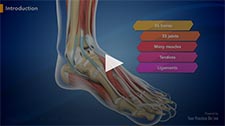
Foot and Ankle Anatomy
The foot and ankle is a complex joint involved in movement and providing stability and balance to the body. The foot and ankle consists of 26 bones, 33 joints, and many muscles, tendons and ligaments.
For more information about Foot and Ankle Anatomy, click on below tabs.
Conditions
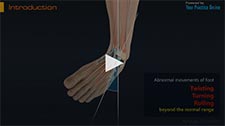
Ankle Sprain
A sprain is the stretching or tearing of ligaments, which connect adjacent bones and provide stability to a joint.
For more information about Ankle Sprain, click on below tabs.
Achilles Tendon Rupture
Achilles tendon is a strong fibrous cord present behind the ankle that connects the calf muscles to the heel bone. It is used when you walk, run and jump.
For more information about Achilles Tendon Rupture, click on below tabs.
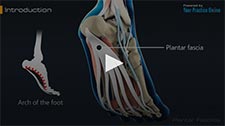
Plantar Fasciitis
Plantar fasciitis refers to inflammation of the plantar fascia, a thick band of tissue that lies at the bottom of the foot. It runs from the heel bone to the toe and forms the arch of your foot.
For more information about Plantar Fasciitis, click on below tabs.
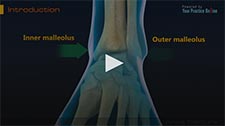
Ankle Fractures
The ankle joint is composed of three bones: the tibia, fibula, and talus which are articulated together.
For more information about Ankle Fractures, click on below tabs.
Ankle Instability
Ankle instability is a chronic condition characterized by a recurrent slipping of the outer side of the ankle. It usually results from repeated ankle sprains. It is generally noticed during movement of the ankle joint but can also occur during standing as well.
For more information about Ankle Instability, click on below tabs.
Nail Bed Injuries
The nail is composed of a nail plate, nail matrix and nail bed. The nail bed is the soft tissue that lies below the nail and is essential for the growth of the nail.
For more information about Nail Bed Injuries, click on below tabs.
Osteochondral Injuries of the Ankle
The ankle joint is an articulation of the end of the tibia and fibula (shin bones) with the talus (heel bone). Osteochondral injuries, also called osteochondritis dissecans, are injuries to the talus bone, characterized by damage to the bone as well as the cartilage covering it. Sometimes the lower end of the tibia or shin bone may also be affected.
For more information about Osteochondral Injuries of the Ankle, click on below tabs.
Stress Fracture of the Foot
A stress fracture is a small crack in the bone which occurs from overuse injury. It commonly develops in the weight-bearing bones of the lower leg and foot. When the muscles of the foot are overworked, or stressed, they are unable to absorb the stress and transfer it onto the bone, which cracks under the pressure.
For more information about Stress Fracture of the Foot, click on below tabs.
Shin Splints
Shin splints or medial tibial stress syndrome (MTSS) is pain around the tibia or shin bone due to inflammation of the tendons, muscles and bone tissue. It occurs because of vigorous physical activity such as with exercise or sports.
For more information about Shin Splints, click on below tabs.
Heel Fractures
The calcaneus or heel bone is a large bone found at the rear of the foot. A fracture is a break in a bone from trauma or various disease conditions. The types of fracture to the calcaneus depend on the severity and include stable fractures, displaced fractures, open fractures, closed fractures and comminuted fractures.
For more information about Heel Fractures, click on below tabs.
Lisfranc (Midfoot) Fracture
The Lisfranc joint or tarsometatarsal joint refers to the region in the middle of the foot. It is a junction between the tarsal bones (seven bones in the foot arch) and metatarsal bones (five long bones in the foot). Lisfranc fracture scan occur due to a fall from a height or traumatic motor accidents.
For more information about Lisfranc (Midfoot) Fracture, click on below tabs.
Talus Fractures
The talus is a small bone at the ankle joint that connects the heel bone and the shin bones, enabling the up and down movement of the foot. Fractures in the talus bone may occur due to a fall from great heights, motor vehicle accidents or sports injuries.
For more information about Talus Fractures, click on below tabs.
Toe and Forefoot Fractures
The forefoot is the front of the foot that includes the toes. Fractures occurring in this part of the foot are painful, but very often not disabling. There are 2 types of fractures namely, traumatic fracture and stress fracture.
For more information about Toe and Forefoot Fractures, click on below tabs.
Turf Toe
Turf toe is an injury to the ligament at the base of the big toe. It is a painful condition which usually results from jamming of the toe into the ground or excessive backward bending of the toe. As it is more common in athletes playing on artificial turf, especially those involved in field sports such as football, baseball and soccer, it is known as turf toe.
For more information about Turf Toe, click on below tabs.
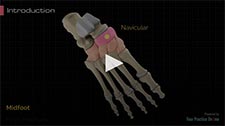
Foot Fracture
The hind foot is separated from the midfoot by the medio tarsal joint and the midfoot is separated from the forefoot by the lisfranc joint.
For more information about Foot Fracture, click on below tabs.
Foot and Ankle Trauma
The foot and ankle in the human body work together to provide balance, stability, movement, and propulsion.
For more information about Foot and Ankle Trauma, click on below tabs.
Ankle Ligament Injury
Ankle ligament injury, also known as ankle sprain, can be caused by a sudden twisting movement of the foot during any athletic event or during daily activities.
For more information about Ankle Ligament Injury, click on below tabs.
Ankle Injury
Osteochondral injuries are one of the most common causes of ankle pain. Though in most cases there is a history of injury or trauma to the ankle joint, a few cases may not have any previous history of ankle injury.
For more information about Ankle Injury, click on below tabs.
Achilles Tendon Bursitis
Achilles tendon bursitis or retrocalcaneal bursitis is a condition that commonly occurs in athletes. It is a painful condition caused by swelling of bursa, a fluid-filled sac which is located at the back of the heel under the Achilles tendon.
For more information about Achilles Tendon Bursitis, click on below tabs.
Bunion
A bunion is a bony protuberance that appears on the external surface of the big toe when it angles toward the adjacent toe. It is an extra bone and a fluid-filled sac that grows at the base of the big toe.
For more information about Bunion, click on below tabs.
Athlete's Foot
Athlete's foot also known as tinea pedis, is a fungal infection on the skin of the foot. It is characterized by itchy, moist, white, scaly lesions between the toes that can spread to the sole of the foot.
For more information about Athlete's Foot, click on below tabs.
Forefoot Pain
Forefoot pain, also referred to as metatarsalgia, is a type of pain that occurs in the ball of the foot (around the tip of the metatarsal bones). Generally, forefoot pain is associated with aging.
For more information about Forefoot Pain, click on below tabs.
Intoeing
In toeing also called “pigeon-toed”, is an abnormal condition characterized by inward facing of the toe or feet instead of being straight.
For more information about Intoeing, click on below tabs.
Morton's Neuroma
Morton’s neuroma refers to a nerve injury between the toes, usually the third and fourth toes, which causes pain and thickening of the nerve tissue.
For more information about Morton's Neuroma, click on below tabs.
Foot Pain
Foot pain occurs from distress induced by certain factors in the foot. Foot pain is a common problem experienced by young athletes involved in different activities such as running and jumping.
For more information about Foot Pain, click on below tabs.
Flatfoot
Flatfoot, also known as “fallen arches” or Pes planus, is a deformity in children’s feet in which the arch that runs lengthwise along the sole of the foot has collapsed to the ground or not formed at all.
For more information about Flatfoot, click on below tabs.
Fungal Nails
Fungal infections are common in nails, and occur most often in toe nails.
For more information about Fungal Nails, click on below tabs.
Foot Infections
Foot infections may occur after trauma to the foot or loss of tissue because of contamination from foreign material and/or bacteria or fungus.
For more information about Foot Infections, click on below tabs.
Foot Drop
Foot drop also known as drop foot, is a sign of an underlying muscular, neurological or anatomical condition, where you are unable to lift the front part of your foot, resulting in foot dragging.
For more information about Foot Drop, click on below tabs.
Hammertoe
A hammertoe is a deformity of a lesser toe (second through fifth toes), where the toe gets bent upward at the toe’s middle joint, resembling a hammer.
For more information about Hammertoe, click on below tabs.
Mallet Toe
Mallet finger is a condition where the end of the finger is bent and does not straighten. It occurs when the extensor tendon on the back of the finger is damaged.
For more information about Mallet Toe, click on below tabs.
Claw Toe
Claw toe is a deformity, where a toe bends and appears like a bird’s claw.
For more information about Claw Toe, click on below tabs.
Limb Deformities
Limb deformities can be congenital (present at birth) or develop at a later stage because of fracture, infection, arthritis or tumor.
For more information about Limb Deformities, click on below tabs.
Club foot and Congenital Deformity
Congenital deformities of the lower limbs are developmental disorders that are present at birth, causing alterations in the shape and appearance of the legs.
For more information about Club foot and Congenital Deformity, click on below tabs.
Ingrown toenail
An ingrown toenail is a common and painful condition of the toe. It occurs when the sides or corner of the nail grow inwards and penetrates the skin of the toe.
For more information about Ingrown toenail, click on below tabs.
Corns
A corn is a circular area of thickened skin developed because of continuous friction or pressure.
For more information about Corns, click on below tabs.
Heel Pain
The heel is made up of the calcaneus bone and supported by a network of muscles, tendons, ligaments and soft tissues, which together support the weight of the body and stress during movement.
For more information about Heel Pain, click on below tabs.
Procedures
Non-Surgical Treatments
Platelet Rich Plasma Therapy
Our blood consists of a liquid component known as plasma. It also consists of three main solid components which include the red blood cells (RBCs), white blood cells (WBCs), and platelets.
For more information about Platelet Rich Plasma Therapy, click on below tabs.
Foot Care
Feet support your body weight, help maintain proper posture and help in movement.
For more information about Foot Care, click on below tabs.
Foot Activity and Exercise Guide
A foot injury or foot surgery may leave you immobile for a period.
For more information about Foot Activity and Exercise Guide, click on below tabs.
Surgical Treatments
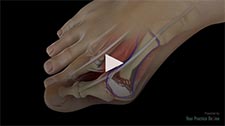
Bunion Surgery
A bunion, also known as hallux valgus, is bony prominence at the base of the big toe, which often results in pain, redness and rubbing in footwear.
For more information about Bunion Surgery, click on below tabs.
Foot Reconstruction
Foot reconstruction is a surgery performed to correct the structures of the foot and restore the natural functionality of the foot that has been lost due to injury or illness.
For more information about Foot Reconstruction, click on below tabs.
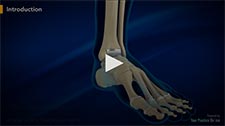
Ankle Joint Replacement
The ankle joint connects the leg with the foot and provides free movement to the foot.
For more information about Ankle Joint Replacement, click on below tabs.
Subtalar Arthrodesis
Subtalar arthrodesis is the surgical fusion of bones that form the subtalar joint.
For more information about Subtalar Arthrodesis, click on below tabs.
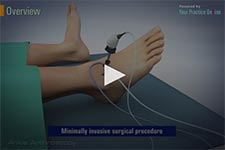
Ankle Arthroscopy
Ankle arthroscopy is a minimally invasive surgical procedure in which an arthroscope, a small, soft, flexible tube with a light and video camera at the end, is inserted into the ankle joint to evaluate and treat a variety of conditions.
For more information about Ankle Arthroscopy, click on below tabs.
Minimally Invasive Foot Surgery
Minimally Invasive Foot Surgery (MIFS) uses the latest advanced technology to treat foot and ankle pain caused by a variety of conditions.
For more information about Minimally Invasive Foot Surgery, click on below tabs.
Treatment of Foot and Ankle Sports Injuries
Injuries during sports are common. They can result from accidents, inadequate training, improper use of protective devices, or insufficient stretching or warm-up exercises.
For more information about Treatment of Foot and Ankle Sports Injuries, click on below tabs.
Cavovarus Foot Correction
To support the entire body’s weight on your two feet, the inner middle portion of each foot (midfoot) is raised off the ground to form an arch.
For more information about Cavovarus Foot Correction, click on below tabs.
Flatfoot Reconstruction
Foot reconstruction is a surgery performed to correct the structures of the foot and restore the natural functionality of the foot that has been lost due to injury or illness.
For more information about Flatfoot Reconstruction, click on below tabs.
Ankle Arthrodesis
Ankle arthrodesis is the surgical fusion of bones that form the ankle joint. The ankle joint is formed by the tibia, talus, and the fibula bones.
For more information about Ankle Arthrodesis, click on below tabs.
Ankle Ligament Reconstruction
A sprain is stretching or tearing of a ligament. Ligaments connect adjacent bones in a joint and provide stability to the joint.
For more information about Ankle Ligament Reconstruction, click on below tabs.
Ankle Tenotomy
Ankle tenotomy is a surgical procedure to lengthen the Achilles tendon enabling the ankle to flex upward and allowing the heel to be placed flat on the floor.
For more information about Ankle Tenotomy, click on below tabs.

Ankle Instability Surgery
Ankle instability surgery is performed to treat an unstable ankle and involves the repair or replacement of a torn or stretched ligament.
For more information about Ankle Instability Surgery, click on below tabs.











